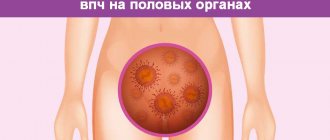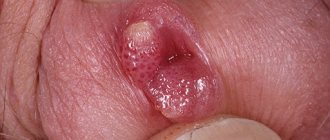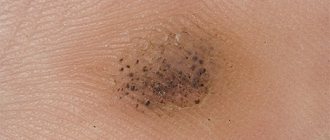Problems with a man’s genital organs can be not only sexually transmitted or urological. In some cases, various unpleasant symptoms may occur due to improper personal care, careless shaving, inappropriate clothing and a number of other factors. One of the frightening symptoms is black dots on the penis. A man who notices such signs will experience serious anxiety. This affects both intimate life and mental state, even if the rash does not cause inconvenience.
Possible diseases
You need to understand that not all spots on the foreskin are caused by harmless reasons. There are a number of diseases that can also provoke their appearance:
- Lichen sclerosus. It appears in the form of white spots on the penis, which do not bother a man in any way except appearance. This disease misleads the patient, who naively believes that if it does not hurt or itch, then there is nothing dangerous. Unfortunately, the process of spreading this insidious disease only begins with white spots on the foreskin. Subsequently, the lesions spread to the frenulum and head of the genital organ. The most difficult complications are considered to be cicatricial phimosis and urethral fusion. Treatment is only surgical - a circular excision of the foreskin is performed (part of the affected skin is already removed) and the remaining elements are polished. Lichen sclerosus is considered a precancerous disease, so it is better not to delay treatment.
- Balanoposthitis. It has many forms that affect the glans and foreskin of the penis. Red spots appear on the skin, itching and flaking are present. A white coating accumulates under the head, which causes the penis to smell unpleasant. It occurs in adolescents due to lack of proper hygiene and in adult men who are sexually active. For primary manifestations, baths based on oak bark and clotrimazole are prescribed 3 times a day for 15-25 days, depending on the severity of the symptoms. But urologists are of the opinion that only circumcision of the foreskin will help solve the problem of all types of balanoposthitis in order to eliminate the possibility of bacteria and fungi accumulating under it.
- Genital herpes. It can also cause bright red spots to appear on the foreskin. Here, a lot depends on the accompanying symptoms, which almost always manifest themselves as severe pain, itching and redness. Next, bubbles with a cloudy liquid appear on the penis, which over the course of the process turn into ulcers. Those, in turn, become crusty and scarred. Genital herpes is treated only under the supervision of a urologist, as there is a high probability of relapse. The type of HSV is determined and effective antiviral drugs are selected.
- Ringworm. Very rarely found on the shaft of the genital organ. Usually localized in the groin and armpits. It appears as brown spots that may peel, but do not hurt or itch. This type of lichen is classified as a fungal disease that is difficult to treat, since its development requires a favorable environment - obesity, excessive sweating, and a special chemical composition of sweat. Not transmitted through sexual or household contact. Treatment depends on the number and size of the rash. Usually they get by with special shampoos and antifungal ointments.
- Vitiligo. An uncommon disease, especially on the penis. But, because of it, small white spots may appear on the foreskin. Over time, the lesions may enlarge and affect more of the genitalia. A distinctive feature is that it is not accompanied by any symptoms. Not transmitted sexually or by any other means. It is not dangerous either for potency or for possible conception. The causes of its appearance are not fully understood, and treatment is even more controversial, since no one has yet been able to cure vitiligo once and for all.
Separately, you need to say a few words about birthmarks, which can also affect the skin of the penis. Their color varies from light brown to black. They do not cause danger, but they still need to be monitored, since there is a small percentage of cases where birthmarks degenerate into melanoma. Therefore, any changes (sharp) - color, size, appearance, etc. should be a signal to visit a dermatologist.
Human papillomavirus
About thirty of the many HPV viruses are localized in the genital area, anus and rectum. One of the most dangerous is HPV-18, which can cause precancerous diseases in men. A person can be a carrier of the virus, but not get sick. The disease manifests itself with age and with decreased immunity. Infection is usually accompanied by some social and medical factors: early onset of sexual activity, multiple sexual partners, bad habits, the presence of sexually transmitted diseases and inflammatory processes in the urinary tract.
HPV-18 provokes the appearance of dark spots on the penis and, in general, in the male genital area. This is a precancerous condition. Without treatment, the spots turn into malignant tumors. Numerous red or purple spots and plaques may appear that grow slowly and may thicken. Additionally, there are always symptoms of reduced immunity: prolonged course of any disease, frequent fungal and colds, gastric ulcers, tuberculosis.
Dark spots on the penis: causes
Dark spots on the head of the penis or its skin may appear suddenly or gradually.
The reason for this can be both infections and diseases not associated with infection. A dark spot on the skin of the penis may be the result of an injury. It is quite possible for spots to form as a consequence of burns or scratching due to itching. In addition to injuries, the reasons leading to the formation of dark spots on the skin of the penis may be:
- hypersensitization
- melanosis
- candidiasis
- diseases of bacterial etiology
- papillomavirus
- herpes viral load
- neoplasms
- tissue necrosis
Types of spots on the penis
A burgundy or dark red spot on the penis is formed due to a fungal infection or herpes virus. In addition, the causes of such spots are often sexually transmitted diseases.
A red spot on the penis is often of a vascular nature. Another reason for the appearance of red spots is allergies. Allergies to the penis are common. As a rule, changes are local in nature. Sensitization may be caused by synthetic underwear, hygiene products, or detergents.
Black spots on the penis occur due to necrotic processes. Necrotization is a process involving local tissue death. This condition is extremely dangerous and can ultimately lead to amputation of the penis.
Blue spots on the penis indicate local circulatory disorders. This occurs due to paraphimosis - narrowing of the foreskin and compression. The blue spot may be a normal bruise after an injury. Brown spots are usually pigmented. Moles that are not a pathology in themselves are also brown.
Therefore, moles on the penis require careful attention. Any change in a mole: growth, itching, pain, requires an immediate visit to the doctor.
Dark spots on the skin of the penis: who to turn to?
If dark spots appear on the penis, it is better not to risk it and consult a doctor.
A urologist carries out diagnostic studies and identifies the causes of the formation of spots on the penis. An examination and subsequent tests will help determine the cause. After the examination, the doctor, depending on the reasons, may refer you to a dermatovenerologist or oncologist.
How to treat dark spots on the skin of the penis?
Treatment for dark spots depends on the cause of their occurrence. Bacterial etiology will require treatment with antibacterial drugs. If dark spots on the penis appear due to candidiasis, they will be treated with antifungal drugs. Allergies are treated by taking antihistamines and treating the causes of the allergies. Papillomavirus and herpes virus are treated with antiviral drugs. For paraphimosis and serious blood flow disorders, surgical treatment is indicated. Treatment of malignant neoplasms may include surgery, chemotherapy and radiation therapy.
If dark spots are not the result of a disease, they do not need to be treated.
If there is severe discomfort due to the aesthetic side of the issue, laser resurfacing is possible. The appearance of dark spots can be caused by the use of retinoid drugs in large doses.
If you notice any spots on your penis, consult a doctor immediately.
Our specialists will carry out an accurate diagnosis and select effective treatment as soon as possible.
Rate this article:
Features of scrotal pigmentation
The scrotum is located between the anus and the penis, and is covered with sparse hair. The scrotum maintains a constant temperature of about 27 degrees to produce enzymes for normal sperm synthesis. The color of the skin of the scrotum changes throughout life. Normally, the shade is several tones darker than the base color of the skin. A change in the color of the genitals by several tones is not a cause for concern if there are no signs of an inflammatory process. This can occur under the influence of an increase in melanin levels, injuries, friction of the outer membranes of the organ against underwear, skin lesions with chemicals over a long period of time (this reaction can be caused by detergent residues). You should immediately consult a doctor if a dark spot appears on the scrotum and it expands, as well as if there are signs of an inflammatory process.
Treatment of sores on the penis
Different treatment methods are used for diseases of different origins.
They are mainly of infectious origin.
Therefore, certain antimicrobial drugs are used.
For all infections they are different.
If syphilis is detected, treatment is carried out with benzylpenicillin.
The therapy does not last long and is successful in 100% of cases.
Because sores on the penis appear at the earliest stage of syphilis, when the pathogen has not yet penetrated the blood.
The course of treatment lasts 3 weeks.
A person is given an injection of 2.4 million units of benzathine penicillin once a week.
If the cause of the sores is a herpes infection, therapy with acyclovir is prescribed.
It is administered orally in the form of tablets or capsules.
It can be used externally in the form of a gel, but this is only an auxiliary element of treatment.
Acyclovir suppresses viral replication and reduces symptoms.
It shortens the duration of the acute period.
But a herpetic infection cannot be completely cured in this way.
Relapses are possible in the future.
If sores on the penis due to herpes appear too often and cause significant discomfort, treatment is required:
- maintenance therapy with acyclic nucleosides;
- correction of immune status;
- the use of a herpes vaccine to enhance specific immunity.
For nonspecific bacterial processes, local antiseptics are used.
They are used for folliculitis or streptococcal pyoderma.
In severe cases, antibiotics may be prescribed orally: doxycycline, cephalosporins, protected semi-synthetic penicillins.
Fungal infections are treated with clotrimazole or miconazole creams.
You may need to take antifungal medications by mouth.
Fluconazole is used in such cases.
Treatment tactics
Dark spots on the penis can be a sign of many diseases. Treatment depends on the specific diagnosis. In case of injuries, surgical intervention may be indicated; in case of bruises, the diseased organ must be provided with rest; STIs and syphilis are treated with antibacterial drugs; mycoses are treated with antifungal drugs orally or by injection; additionally, ointments are prescribed for topical use. Vitiligo currently has no cure. For genital herpes, the use of Acyclovir, local antiherpetic and anti-inflammatory drugs is indicated. If the patient is diagnosed with eczema or psoriasis, then corticosteroids are prescribed, and for balanoposthitis, antibacterial drugs for topical use are indicated.
Types of neoplasms and symptoms of pathology
Spots on the penis come in various sizes, shapes and colors. It depends on the disease that influenced their appearance. Experts distinguish such types of pigmentation as:
- Round spots with clear boundaries, the color of which ranges from brown to pink;
- Blurred pigmentation with a dark color;
- Small red rashes that are accompanied by itching.
The first type of spots appears due to a fungal infection of the skin. Fungal infections have various causes. The main type of fungus that affects the penis is Candida. This type of fungus lives on people's skin constantly. Under the influence of various factors, the bacterium begins to aggressively multiply and infect human skin. Treatment is carried out under medical supervision.
Blurred pigmentation occurs under the influence of hormonal changes. A man's body contains a variety of hormones that affect the normal functioning of the reproductive system. The main hormones are testosterone and estradiol.
If the level of estradiol is disturbed, or rather, falls, then a change in the functioning of endometrial cells occurs. Melanocytes react to the decline of the hormone and begin to actively produce the pigment - melanin. The skin of the genitals, nipples and armpits darkens. Treatment consists of normalizing hormonal levels.
Small rashes on the penis are the most common type of pigmentation. Such spots accompany the development of an allergic reaction. In the first stages of the disease, a man experiences a burning sensation in the skin of the penis. The development of pathology is accompanied by itching of the affected area. Small spots appear on the genitals. They can have a wet or dry surface. Treatment is accompanied by identifying the causes of allergies.
Allergic reaction
The reaction occurs as a result of an allergen entering the body. Barrier contraceptives, intimate lubricants, hygiene products, or laundry detergent can cause dark spots to appear on the glans penis. Itching most often appears with balanoposthitis, but can also be characteristic of some other diseases of an allergic nature.
Types of neoplasms on the genitals
In men, growths are most often white and red, less often flesh-colored. You need to understand that some of them are not considered a pathology and do not require treatment/removal. Let's take a closer look at each of them.
Pearly papules
They are also called hirsutoid papillomas or pearl necklace around the glans. They are cone-shaped or thread-like growths with a matte-shiny flesh-colored surface. Sometimes they are so small that they look like small pimples. Papillomas are located close to each other, but do not merge. All elements have the same size, which does not change over time. Papules are localized around the circumference of the crown or on the head itself in 1-2 rows. The formation of hirsutoid papillomas is not accompanied by itching, burning and pain.
Pearl necklace does not pose a health risk and is not contagious. This is overgrown connective tissue of the gland ducts. Therefore no treatment is required. Despite this, many men want to remove pearlescent papules for cosmetic reasons. Medicine offers several modern methods at once, from cryotherapy to laser. It should be remembered that there is no guarantee of their reappearance. And the removal procedure itself, it must be said, is not cheap.
Fordyce granules
White growths on the head of the penis are seborrheic cysts. They look like white or yellowish nodules about 1 mm in diameter. They are usually numerous and located in groups. Appear on the head and shaft of the penis. There is no physical discomfort.
Although granules appear due to developmental abnormalities, they are not a pathology. In some people, the sebaceous glands are located closer to the epidermis than they should be. With a hormonal surge, especially in young men in adolescence, there is an increased production of sebum. The gland ducts become clogged and Fordyce granules appear. Since it is not a disease, no treatment is needed.
Molluscum contagiosum
It is characterized by the appearance of small flat nodules on the skin of the penis, which quickly increase in size and reach 5-7 mm in diameter. The formed mollusk is hemispherical in shape and flesh-colored. At first it is hard, then it becomes softer. A depression with a white dot forms in the central part of the growth. When pressed, a cheesy plug comes out. Single rashes or groups of up to 10 pieces are possible. The elements can merge, forming a large lesion up to 2 cm in diameter.
Molluscum contagiosum on the genitals is transmitted sexually. The causative agent is a type of smallpox virus. But only the skin is affected, and people with normal immunity do not experience complications. The rash disappears on its own within six months. After the last element dies off, the virus completely disappears from the body.
Chancre
Red growths on the head in men can be a sign of syphilis. Hard chancre is a hemispherical compaction of flesh-red color with a smooth and shiny surface. There is no bleeding or physical discomfort. Possible simultaneous enlargement of lymph nodes. The neoplasm lasts 6-7 weeks, after which it disappears. Then secondary syphilis begins with extensive damage to the skin and internal organs.
A chancre appears at the site of introduction of the causative agent of the disease - Treponema pallidum. Transmitted primarily through sexual contact. Infection through blood is also possible. Household transmission is rare. It should be remembered that at the initial stage it may appear as a small red spot on the head of the penis, which quickly increases in size.
Papilloma
A skin growth in the form of a ball on a thin stalk or flat base. There are cone-shaped elements called genital warts. They can grow and merge with each other, forming lesions in the form of cauliflower or cockscomb. There are no subjective sensations, only slight itching is possible.
The causative agent of the disease is the human papillomavirus. It is transmitted primarily through sexual contact. Infection from mother to child during childbirth or breastfeeding is also possible. It is believed that the virus is constantly in the body of about 90% of people. But only people with weakened immune systems get sick. Self-healing is possible if you live a healthy lifestyle.
Melanosis
A condition characterized by excessive accumulation of skin pigment in certain areas. May be congenital or acquired. It appears as an ordinary mole or blurry spot. Does not require treatment. For lightening, ointments and creams with vitamin A are used. Laser resurfacing will help completely get rid of the defect, but this method threatens the loss of sensitivity of the head. Sometimes melanosis is caused by a malfunction of the internal secretion organs or poisoning. Therefore, if the appearance of pigmentation is accompanied by a general deterioration of the condition, it does not hurt to visit a doctor.
Diagnostics
The appearance of blackheads or other rashes is often caused by sexually transmitted diseases. Therefore, even if there are no additional symptoms, but dots appear, it is recommended to visit a doctor. You can contact a dermatologist, venereologist, urologist or therapist.
Diagnostic methods:
- urine and blood analysis;
- bacterial culture to identify bacteria;
- spermogram;
- laboratory analysis of discharge (if any);
- PCR, Daijin test (tests that help identify papillomaviruses).
Spots on the penis with pityriasis versicolor
This is a common skin condition caused by an overgrowth of the yeast Pityrosporum orbiculare (Malassezia furfur).
Pityriasis versicolor (pityriasis versicolor) is usually seen on the upper back and chest, but the disease can be found anywhere on the body.
The genitals, including the penis, and the scalp are rarely affected.
The disease is characterized by the development of spots that may be yellow or brownish, and sometimes red or pink.
Predisposing factors for the development of Pityriasis versicolor include:
- Living in a warm and humid climate.
- Increased secretion of sebum.
- Hereditary predisposition.
- Weakening of the immune system.
For most people, pityriasis versicolor responds well to treatment, but the discoloration of the skin may persist for several months.
The infection is treated with antifungal medications.
When lichen develops on the penis, local medications are prescribed, most often Fluconazole ointment.
The drug must be applied to the affected area of skin once or twice a day for several weeks.
The diagnosis is based on a typical clinical picture; in addition, the doctor may use a Wood's lamp.
Differential analysis includes:
- Idiopathic pigment loss.
- Vitiligo.
- Post-inflammatory reaction.
- Seborrheic eczema.
- Shingles.
- Dermatomycosis.
Prevention
Preventive methods include general rules of self-care:
- Be picky in your intimate life.
- Be careful during sexual intercourse. Dots and rashes on the skin can appear due to bumps, bites, pinches, chafing, or as a reaction to intimate lubricants.
- Observe personal hygiene rules. The genitals should be washed twice a day, and even more often in hot weather or when sweating profusely. Underwear should be changed preferably once a day or more often - after training in the gym or physical activity.
- Choose high-quality underwear that does not cause skin problems, and high-quality washing powder.
- Use suitable genital care products (antibacterial soap, intimate gels).
It is also necessary to monitor your health. Rashes can appear due to malfunctions of the hormonal, immune, and nervous systems.
Possible reasons for the appearance
There are a number of pathologies that cause men to develop white spots on the glans and foreskin. Some of them are harmless, but there are also quite serious diseases:
- Lichen sclerosus.
- Vitiligo.
- Candidiasis balanoposthitis.
- Genital herpes.
- Fordyce granules.
Of all the above, only Fordyce granules are considered an absolutely safe phenomenon that affects the genital organs of men aged 20-45 years. The most dangerous on the list is lichen sclerosus, which is considered a precancerous disease.
Fordyce granules
There are no reliable reasons for their appearance, but they are closely related to puberty, as they most often occur in adolescents. Symptoms are varied, ranging from the appearance of a small white spot on the head and ending with many papules densely located with each other. Most often they are found on:
- testicles;
- foreskin;
- head of the penis;
- bridle.
There are no subjective sensations even when touched. Removal is carried out only for cosmetic purposes; there are no medical indications for this. Fordyce granules on the glans occur in 30-50% of men aged 20-45 years. They are not sexually transmitted and are considered a normal variant in all countries of the world.
Lichen sclerosus
The most common cause of white spots on the head of the penis. It all starts with a harmless white speck that doesn’t show itself in any way. However, lichen is a constantly progressive disease that can lead to cicatricial phimosis and urethral fusion. There are also cases of transformation into penile cancer. In advanced cases, the entire head, frenulum and part of the foreskin may turn white. There are urologists who are trying to cure lichen sclerosus at the initial stage with the help of ointments, but practice shows that this is wasted time and there is only one way out - circular excision of the foreskin and radio wave resurfacing of all remaining lesions. The cost of the operation starts from $300, the duration depends on the symptoms (on average 30-50 minutes), healing up to 7 days. Treatment is outpatient.
Candidiasis balanoposthitis
A common pathology that is often compared to female thrush. There are some similarities in symptoms - red spots appear on the head of the penis, which are covered with a whitish coating. Visible signs are combined with an unpleasant odor from the organ and a feeling of stickiness on the head even after thorough washing. Advanced cases can lead to the formation of white ulcers over the entire surface of the penis. There is severe itching and pain during ejaculation and urination. The disease is based on the Candida fungus, which is normally present in every man. Its activity can be provoked by unprotected sexual intercourse with a patient with candidiasis, long-term use of antibiotics and hidden sexually transmitted infections. Also, candidal balanoplstitis often occurs against the background of diabetes mellitus and HIV. The treatment is complex - ointments applied externally and antifungal tablets internally until all symptoms disappear.
Genital herpes
A viral disease that is sexually transmitted and occurs with characteristic symptoms in the form of a blistering rash on the penis, pain and itching in the affected areas. Transmitted by any sexual route (oral, anal, etc.). In advanced cases, ulcers may appear in the form of white spots on the head and foreskin. All symptoms of genital herpes in men are highly treatable, especially at an early stage, but there is a high risk of relapse. Therefore, as a preventive measure, it is recommended to undergo strengthening vitamin therapy annually.
Vitiligo
The disease is considered a rare genetic disorder that usually affects the upper part of a person's body. But, there are cases where vitiligo affected the groin and genitals. A distinctive feature is discoloration of large areas of the skin. Therefore, in men, vitiligo may appear as large white spots on the head of the penis. The number of lesions can number several dozen. To date, there is no effective treatment for vitiligo in any part of the body, not to mention the groin area, where the use of a laser, unless absolutely necessary, is considered undesirable.
Causes
The prerequisites for the appearance of these tubercles on the head of the penis in a man are:
- Basic lack of hygiene. The head of the penis contains sebaceous glands. The latter secrete a secretion, which, when mixed with dead epithelial tissue and moisture, is smegma. If you do not regularly wash the genital organ, smegma accumulates and dries out. And thus, surprisingly convenient conditions for inflammation and breeding of a whole “farm” of pathogenic microorganisms are formed on the head of the phallus.
- Puberty. This reason is absolutely natural and does not pose any danger. White spots on the penis of a young man do not create a burning or itching sensation, they do not peel off, and do not cause any discomfort other than aesthetic ones. It’s just that during adolescence, the male hormone testosterone increases extremely in future men. And it, in turn, creates increased excretory activity of the sebaceous glands on the skin of the genital organ. In this case, white spots on the penis occur because these glands swell, not having time to secrete such a large flow of secretion to lubricate the skin. When sebum production normalizes, all the small white dots on the penis will disappear. But for this you must follow all the rules of hygiene.
- Infectious diseases that are acquired through sexual contact. Promiscuous sexual intercourse often leads to various infections of the male genitals, especially if the man does not use a condom in such relations. This can lead to the formation of genital herpes, chlamydia, syphilis, gonorrhea and much more. Papillae on the head of the penis are an undesirable phenomenon. Protected sex and choosing a partner not for the night, but for a lifetime, can protect you from it.
- Papilloma virus. It is expressed in the growth of genital warts, which can affect not only skin tissue, but also mucous membranes. These growths settle at sites of injury during sex, into the unprotected areas of which the virus penetrates.
- Thrush. This fact may surprise men, but this does not negate the fact that such a disease can also develop in the stronger sex. Candidiasis (thrush) is a fungal disease. When it appears, a whitish coating is observed on the male organ.
- Allergy. If you wear panties that are made of synthetic materials, then there is a possibility of an allergic reaction. It can also occur if your body “does not accept” the composition of intimate soap or shower gel. In this case, it is necessary to wear underwear that is made only from natural materials. Or you need to change intimate hygiene products to those that suit you.
- Features of anatomy and overheating. White bumps on the penis can simply be an ingrown hair or an accumulation of sebaceous gland secretions, even in mature men. An accumulation of sebum can form due to sweating when the genital organ is overheated. This happens when a person wears underwear that is too tight. And this causes a lack of free air flow, which can result in diaper rash.
Therapy methods
Treatment may be medication or surgery.
The most effective method is medication. Drugs are prescribed depending on the main diagnosis:
- 1. To treat an infectious lesion, antiviral, antifungal or antibacterial agents are used, depending on the etiology of the disease. Additionally, broad-spectrum antiseptics are prescribed: chlorhexidine, Miramistin.
- 2. A rash of an allergic nature is eliminated with the help of local and systemic antihistamines.
- 3. Topical creams and ointments are used to relieve itching.
You should not take medications without a doctor's recommendation, as this may worsen the situation.
Melanoma is treated with surgery and radiation therapy.
Papillomas, condylomas, warts, scarring are eliminated with laser. This is a minimally invasive surgical technique that allows you to achieve a cosmetic effect.
A cosmetic problem can be solved by polishing areas of the skin or prescribing vitamin A oil. If it is necessary to remove a birthmark, cryodestruction and electrocoagulation methods are used for this.
Red spots on the penis due to allergies
Allergic reactions have very diverse clinical manifestations.
These may be spots, papules, blisters, etc.
Sometimes inflammation upon examination looks exactly the same as an infectious process.
An allergy is a pathological reaction of the body to a certain substance.
An inflammatory reaction is triggered after it comes into contact with the skin, inhalation, ingestion, or intravenous administration.
It does not matter how the allergen entered the body. A pathological reaction develops in any case
A pathological reaction develops in any case.
It can occur immediately after the penetration of the allergen, if it is strong.
With a weak allergen, the reaction is less pronounced and appears later.
Sometimes red spots first appear on the penis only a few months after contact with the allergen.
Subsequently, when the body becomes sensitized, allergic reactions develop within a few minutes or hours.
Obviously, if the spots appeared due to an allergy only on the penis, and nowhere else, then they arose due to direct contact of the skin with the allergen.
It could be:
- lubricant;
- linen;
- drugs;
- spermicides;
- condom.
Allergic reactions can occur after sexual contact with a woman if she uses any intravaginal means: drugs or contraceptives to which the man is allergic.
After such contacts cease, the spots disappear.











